by Graham J. Darling (as Doctor Carus of Burn Abbey). First published in North Wind, 2012 June, n° 348, p 8-9.
Dear Dr. Carus,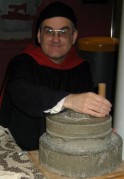
Oh, wool is me! Drop spinning may be portable, but it’s so slow! I got myself one of those new fangled spinning wheels, but every time I prick myself, I delay my A&S project by a hundred years! When did we switch over to these infernal things, who invented them, and will I ever have enough wool for a skein or two to knit up my ravelled sleeve of care?
Sincerely,
Fit to be Dyed
Dear Fit,
Truly the Good Book says:
“Who can find a woman of worth? Far beyond jewels is her value. […] She puts her hands to the distaff, and her fingers ply the spindle. […] Acclaim her for the work of her hands, and let her deeds praise her at the city gates.” [1]
Now imagine how much more acclaimed you’d be if you were to increase your spinning productivity by up to TENFOLD with the *new* improved Pray-Tel Spinning Wheel™! (c/o Burn Abbey – Brother Operators are standing by to take your order) With this extra household income, you’ll soon be “spinning flax into gold” – wealth through value-added product, the dream of Alchemy!
The allegation of narcoleptic hazard supposedly comes from the following story [2]. Fairies gathered at the christening of a princess bestow gifts (surely from Germanic myth of spinning goddesess who assemble to order the life of a human at birth: called Norns [3], equivalent to the Greek Moirai and Roman Nona or Fates), and one a curse, that the girl will one day prick her finger spinning and die, that another tempers to an enchanted sleep. Yet, these labour-saving devices, in their latest version complete with treadle and separate spindle (that twists the yarn) and flyer (that winds the yarn about the bobbin), and in regular use from the 15th – 16th into the early 20th C (see Exhibits A & B), have in fact no actual sharp bits on which a finger may be pricked!
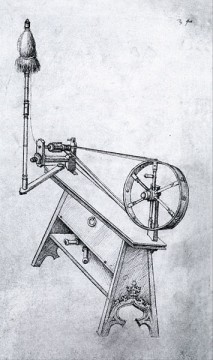
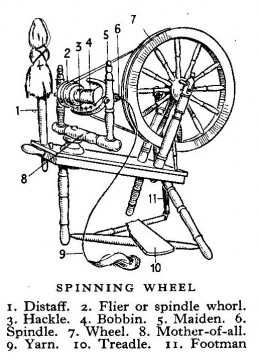
Though later potted translations and illustrations talk about deadly spinning wheels (see Exhibit C) – so that a scurrilous movie version [7] even has the princess prick her finger on the end of one’s distaff, from which is drawn the unspun roving or tow: a point that is utterly, er, pointless – it is the earlier drop-spinning spindle, relatively unfamiliar to modern audiences, which narrows towards one or both ends that it may twirl the faster when spun between two fingers, that is specified in the original versions of the tale (Exhibit D). And one can indeed get dead or disabled from a spindle-prick: tetanus is Period [8], though it involves more rigid spasm than relaxed coma. As for sleep or other “enchantment” (besides occasional yet complete recovery from the above): in a horrific and Definitely Not For Children earlier version [9], the etiology is given as an injected bit of either flax or hemp (Cannabis sativa) – possibly relating to the narcotic action of certain extracts of the latter.
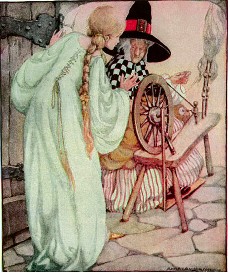
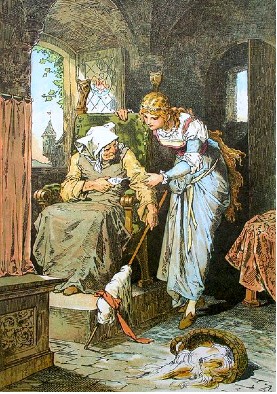
Is then the wheel entirely irrelevant? Not necessarily. The very first kind of spinning wheel, called the Great or Walking Wheel (Exhibits E & F below), similar to the chahrka famously worked by Gandhi while he preached Revolution (and that India’s flag recalls today), and that probably appeared in Persia around 1200, had a hand-cranked big wheel & belt to merely spin a sharp spindle, alternately from whose end thread was twisted then on whose side thread was wound: conceivably this could drill a pretty hole into an unwary hand in no time flat, with a variety of unfortunate consequences. Interestingly, in China a water-driven version was developed by the 14th C, four centuries before Europe, but then was forgotten because labour there was so cheap, forestalling an Eastern Industrial Revolution [12]. It was eventually displaced by the multi-bobbin spinning jenny after 1764, but it is a lasting legacy of the spinning wheel that, wherever and in whatever form it had appeared, spun & woven textile quickly became so inexpensive that enough linen rags were available to remove an important bottleneck in the manufacture of books, and encourage their mass production through printing: not mass sleep, but a Great Awakening, was its gift to the world [13].
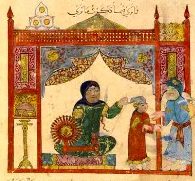
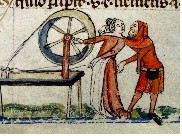
References:
1. Proverbs 31:10,19,31.
2. Charles Perrault “La Belle Au Bois Dormant / The Beauty of the Wood Sleeping” in Contes de Ma Mère l’Oie / Tales of My Mother the Goose, 1697, tale 1; Jakob & Wilhelm Grimm “Dornröschen / Briar Rose”, in Marchen / Fairy Tales, 1812, vol 1, märchen 50.
3. Snorri Sturluson Prose Edda, 1220, part 1, sec 15.
4. Anonymous Mittelalterliches Hausbuch / Medieval House Book, ca. 1480.
5. Leonardo da Vinci Notes, ca. 1490.
6. P.J. Rehtmeyer Chronicle of Brunswick-Luneburg, 1722, p 879.
7. W. Disney Sleeping Beauty, 1959.
8. Hippocrates, Aphorisms, 5th C BC, book 5, aphorism 6.
9. Giambattista Basile “Sole, Luna, e Talia / Sun, Moon, and Talia”, Pentamerone, 1634.
10. Anne Anderson Old, Old Fairy Tales, 1919.
11. Alexander Zick Dornröschen, 1875.
12. Mark Elvin “The high-level equilibrium trap: the causes of the decline of invention in the traditional Chinese textile industries” in W. E. Willmott, Economic Organization in Chinese Society, 1972, p 137–172, http://tinyurl.com/76robml .
13. C. Marchetti “A Postmortem Technology Assessment of the Spinning Wheel: The Last 1000 Years,” Technological Forecasting and Social Change, 1978, vol 13, p 91-93, http://www.cesaremarchetti.org/archive/scan/MARCHETTI-079.pdf .
14. Al-Hariri of Basra Maqāmāt , 1237.
15. Smithfield Decretals, ca 1400, book 4, folio 139.
Further Reading:
Lady Siobhan nic Dhuinnshleibhe / Heather McCloy, A History and Evolution of Spinning, 2000, http://kws.atlantia.sca.org/spinning.html.
FM Feldhaus “Ancient History of the Spinning Wheel”, The Melliand, 1929 Sept, vol 1, n° 6, p 945-947, https://web.archive.org/web/20160307102529/http://www.cs.arizona.edu/patterns/weaving/articles/fmf_spin.pdf.
Frances & Joseph Gies Cathedral, Forge, and Waterwheel, 1994, p 175-176.
AP Usher A History of Mechanical Inventions, Revised Edition, 1954, p 267-273.